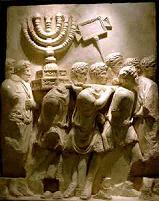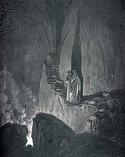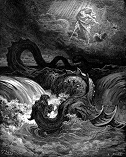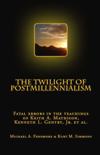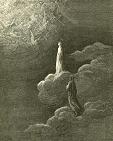Geographical Distribution of Demon Possession
Mapping Demon Belief in the New Testament
by
S. Snobelen
Abstract
Demon-possession in the Gospel accounts is not a
geographically-uniform phenomenon. Specific cases of
demon-possession in the synoptics occur in regional clusters,
always in northern environs such as Galilee, rather than
occurring throughout every location through which Christ
travelled and performed healings.
Conversely, not a single case of demon-possession in Judea or
Jerusalem is recorded by Matthew, Mark, Luke or John. Moreover,
the Synoptics include several quantitative summaries of
demon-possession that imply that demon-possession was a common
and even characteristic phenomenon in Galilee and the northern
regions. No comparable statements for Judean areas are found in
the Gospel records.
Finally, certain ostensibly physical pathological conditions,
such as blindness, deafness and muteness, which are sometimes
attributed to demon-possession in the north, are never so
characterized in the south, even though descriptions of these
conditions do occur in texts commenting on the Judean ministry.
The evidence: a geographical survey of demon possession in the
synoptics
Jesus was raised in Nazareth, a town in the Roman province of
Galilee. Aside from the intense period leading up to his
crucifixion, the synoptic Gospel accounts show that Christ spent
most of his three years’ ministry in the north, particularly,
but not exclusively, in Galilee. The records themselves attest
to a great number of cases where Christ healed demoniacs,
although only a few of the cases are commented upon in detail.
The following will summarize the data.
First, we find evidence from particular statements in the
synoptics that demon possession was common in Galilee and the
north. A few examples will reveal the general tenor of these
statements. In the opening chapter of Mark we are told that
Jesus “cast out many
demons” (daimonia polla) and that “he went throughout all
Galilee, preaching in their synagogues and casting out demons”
(1:34 and 39; all quotations from the RSV).
Mark also recounts that the twelve disciples both healed many
who were sick and “cast out many demons” (daimonia polla; 6:13).
Matthew records the same occasion as that described in Mark 1,
and mentions the locals in Capernaum bringing “many who were
possessed with demons” (daimonizomenous pollous; 8:16; cf. Luke
4:41).
On another occasion in Luke 7:21, we find Jesus, while near
Nain, curing “many of diseases and plagues and evil spirits.”
These examples, with their deliberate emphasis on the great
number of demoniacs, demonstrate that whatever the situation
elsewhere, demon possession was common in Galilee—even endemic.
As with these quantitative summaries, when we turn to examine
specific examples, we see that all such cases of demon
possession occur in the north, and usually in Galilee. For
example, the first healing of a demoniac recorded in Mark occurs
in the synagogue of Capernaum (1:21-8). Mark also mentions the
case of a demon-possessed girl from Syrian Phoenicia in 7:24-30,
another northern region. Mary Magdalene, from whom seven demons
were cast out, was from Magdala, on the shores of the Sea of
Galilee. The most celebrated case of demon possession in the New
Testament—that of the Gadarene demoniac—occurred in the north as
well, beside the Sea of Galilee (Matthew; Mark; Luke ).
When we turn to the fourth Gospel account, we discover that John
does not record a single case of demon possession, although he
does mention people with sickness. Many scholars have noticed
this and have offered suggestions as to why this should be so.
One theory is that John came from a Sadducean background and,
since Sadducees did not believe in demons, he refrains from
mentioning them. Aside from the fact that there is no strong
evidence for this theory (and in any case, the Book of
Revelation tells us that John certainly believed in angels), a
better explanation of this apparent anomaly lies in the fact
that John, unlike the synoptics, concentrates almost entirely on
the south.
The disproportionate ratio of coverage between north and south
in the synoptics is reversed in John. With John we have almost
an entire Gospel account devoted to the Judean ministry in which
demons could appear. Yet, they do not. This is further evidence
for the clustering of demons in the north.
In order to confirm the northern bias of demon-possession during
the ministry of Jesus, I analysed every reference to demons and
evil spirits in the Gospel accounts, paying close attention to
the location of each occurrence. The results of this survey are
displayed in the accompanying table and map.
To strengthen the above-outlined pattern even further, we can
take an additional step and note that there is a difference
between the way some examples of physical ailments are described
in the north when compared with the south. Illnesses mentioned
in the south are always treated as purely organic conditions,
while in the north they are sometimes treated as afflictions
caused by demons. Thus we see some cases of blindness, deafness
and muteness in the north attributed to demons. In Mark 9:14-29
we are provided with an account of a boy possessed by a “dumb
and deaf spirit” (9:25; cf. 9:17).
Moreover, Matthew 9:32-3 records an incident in which Jesus
healed a mute man, who was thought to be possessed by a demon.
Furthermore, another man afflicted by a demon is described in
this same Gospel account as “blind and dumb” (12:22; cf. Luke
11:14). Cases of the blindness in the south are depicted quite
differently.
After his triumphal entry into Jerusalem, Jesus healed people in
the Temple who are simply described as being blind (Matthew
21:14). The man born blind in John 9 did not find himself in his
condition because of demonic affliction.
As for blind Bartimaeus from Jericho—he is just “blind
Bartimaeus,” not “blind, demon possessed Bartimaeus” (Mark
10:46-52). All this, even though his actions are similar to that
of a demoniac: he cries out and attributes Biblical titles to
Jesus (Mark 10:47-48). This demonstrates that even demon-like
behaviour in the south was not readily attributed to evil
spirits.
Why is it that such physical problems are sometimes attributed
to demonic agency in the north, but never so in the south? What
was so special about Judea that drove away demons? These
examples also demonstrate that it is wrong to assume that all
cases of demon possession relate to mental illness.
To sum up, the results reveal that every single case of
demon-possession in the Gospel accounts occurs in the north,
outside Judea; there are no examples of demon-possession in
Judea or Jerusalem recorded in any of the four Gospel accounts.
What is more, there are several occasions in the Synoptic
treatments of the Galilean ministry where we are told that Jesus
healed many people possessed by demons. Again, this is in stark
contrast to the lack of even a single reference to demon
possession in the Judean ministry.
Possible objections considered
Next, we must test this pattern for flaws or alternative
explanations. If the pattern is real and significant, it must be
able to stand up to rigorous objections. Could it be that there
are no accounts of demon possession in Judea because no miracles
of healing are recorded there at all? No, there are miracles of
healing recorded in both Judea and Jerusalem. Could this pattern
be the simple result of the fact that the synoptics spend so
much time focusing on the Galilean and northern ministry? No,
because, once again, miracles of healing are recorded in Judea.
The accounts of the southern ministry in the synoptics, while
not as extensive as the accounts in the north, are by no means
insignificant: there was ample opportunity to record cases of
demon-possession, if they occurred in that region.
Also, when we turn to John, we see that the majority of his
Gospel account deals with the Judean ministry and there is not a
single reference to a healing of a demon-possessed person (the
only references to demons in John occur when Christ is accused
of having a demon — which seems to have been a standard form of
slander and abuse among Jews). Thus the pattern holds up in the
Gospel accounts.
It is only when we leave the Gospel accounts that we find two
possible exceptions to this general pattern. First, in Acts 5:16
we read that those with unclean spirits were brought from the
towns “around” or “in the vicinity of Jerusalem” to be healed by
the Apostles.
The Greek is not overly
precise, so it is hard to say from how far away these
demon-possessed people came, but the language does show that
wherever they were from, they were not from Jerusalem itself—the
main centre for Jewish religious teaching in Judea. But it is
worth noting that this is the only example in the book of Acts
of demon-possession in a predominantly Jewish region. Based on
the pattern of the Gospel accounts one would expect examples
around every corner. Yet this is not the case.
The other apparent exception comes in Acts 10:38 where Peter,
giving an account of Christ’s ministry, noted that Christ healed
all who were oppressed of the devil (ho diabolos). First, it
must be stressed that Peter does not specifically use the word
demon (daimonion), and it is possible that this distinction is
not without import.
Second, while it is true that Peter mentions that the ministry
of Christ took him through first Galilee and then Judea (10:37),
he does not specifically mention where the healings of those
oppressed by the devil took place. His is a general statement
about Christ’s ministry as a whole, and since most of Christ’s
ministry took place in Galilee, the greatest force of the
statement about demons (assuming the reference is to demons)
would naturally apply to that region.
As a Galilean himself, the cases of demon possession would have
left a strong impression on him, and it is thus not surprising
that he should mention them in such a summary of Christ’s
ministry. Also, the summary statement of healing is no less true
if Peter knew that those oppressed by the devil lived in
Galilee. There is no necessary contradiction in stating that
Christ worked in Galilee and Judea on the one hand, and that he
healed all oppressed by the devil (or demons) in the north.
Furthermore, it is a long established principle of Biblical
exegesis that unclear passages should be interpreted by those
more easily understood. In this case, as we have seen, the
wealth of testimony from the Gospel accounts confirms that every
example of demon possession during the ministry of Jesus
occurred in the north. Nevertheless, even if, for the sake of
argument, Peter’s summary statement is meant to include
otherwise unrecorded cases of demon-possession in the south,
such information would in no way counter what would still be an
overwhelming trend.
Christ’s words to his disciples in Mark 16:17 offer another
possible exception: “In my name shall they case out demons.”
Once again, however, we are dealing with a general statement
with no specific geographical cues. Nevertheless, the statement
is clearly prophetic, so we can confirm just how it was
fulfilled by consulting the rest of the New Testament. Here we
see that the Apostles (including, later, Paul) did in fact
encounter cases of demon-possession after Christ’s ascension.
But, the point is that with the possible exception of Acts 5:16,
these cases occurred in Gentile dominated regions outside Judea.
Absolutely no cases occurred in Jerusalem, and no individual
cases are highlighted from Judea.
With regard to any unrecorded cases, we may expect that the
pattern revealed during the ministry of Jesus would continue in
the years immediately afterward his ascension. But the force of
the impressive pattern of clear examples from the Gospel
accounts cannot be taken away by the three above possible
exceptions. If belief in demons was much weaker in Judea than in
Galilee, we would still expect to see some belief in demons in
the south, just as we should not be surprised if some in the
north did not believe in demons. The “demons” may not have
travelled, but people and ideas certainly did.
The point is: the general pattern holds up even if there are
some limited exceptions. What is more, even if we are only
dealing with a general pattern of demonic activity during the
ministry of Christ (i.e. including some possible unrecorded
Judean cases as well), it is still true that none of the
examples explicitly listed in the Gospel accounts occurred in
the south. There must be a reason for this inbuilt into the
inspired Word. And even if we are only witnessing a general
pattern, this fact alone gives us a compelling reason to seek
for explanations.
Given this very powerful evidence, therefore, we must ask: what
is going on? Why do we find so many demons in the north and so
few (if any) in the south? Why are organic ailments in the north
sometimes attributed to demonic activity, but never in the
south? For the person who believes in the inspiration of
Scripture these examples can be neither accidental nor without
purpose. Something is being taught by this pattern.
There are two general explanations: the first is
historically-based, the second comes straight from the Bible. We
will begin with the historical explanation, and outline the
biblical one at the conclusion of this article.
Belief in demons in Galilee and Judea
Based on his studies of the relevant Talmudic literature,
Cambridge rabbinical scholar Herbert Loewe concluded that during
the first century AD rabbis in Galilee and Mesopotamia generally
believed in the literal existence of demons, while those in
Judea did not. Loewe first of all includes a commendable appeal
for the need to exercise great care and sensitivity with respect
to local and chronological distinctions:
‘...references must be examined to see whether they are the
utterances of individuals or genuine examples of popular belief;
and distinctions must be drawn between local and general
beliefs, between Semitic and non-Semitic, and between Jewish
beliefs and those borrowed by Jews from their neighbours in
European countries.
A requirement more vital than any of the foregoing, is the
exercise of careful analysis in selecting Talmudic material. It
is absolutely necessary to assign each authority to its proper
local and chronological category; that is to say, evidence which
applies to Babylon is inadmissible for Palestine; that which is
found to occur in Galilee cannot be used to prove arguments for
Judaea; and the same care must be exercised in respect of
chronology.’
Loewe next summarizes the results of his findings:
‘In investigating Talmudic evidence as to spirits, the reader
will notice, at the outset, different attitudes adopted by the
Rabbis in dealing with this question. In some cases the reality
of demons seems to be taken for granted absolutely; in others it
seems, with no less certainty, to be denied. Stories occur in
which both these attitudes may be traced simultaneously. The
reason for this may be found if the nationality of the
respective teachers be sought. It has already been stated that
Galilee was the centre of Palestinian demonology, and it will
almost invariably be found that Galilaean teachers accepted,
while Judaean teachers rejected, the existence of spirits. The
numerous instances which the NT furnishes would have been
impossible save in Galilee; there is a strong similarity between
these and those adduced by Galilaean Rabbis. The same must be
said of those Rabbis who came from Mesopotamia. And they were
brought up in surroundings in which superstition was rife, their
teaching was tinged by a belief in spirits, and in comparison
with them the clarity of Palestinian teaching stands out in bold
relief.’ Loewe, “Demons and Spirits (Jewish),” Encyclopaedia of
Religion and Ethics, ed. James Hastings (Edinburgh, 1911),
4:612-13 (emphasis as in original). See also H.A. Kelly, Towards
the death of Satan: the growth and decline of Christian
demonology (London, 1968), p. 68
Loewe then goes on to cite supporting evidence from the Talmud
to show that superstitious belief in demons was a characteristic
feature of rabbinical teaching in Galilee, while a sceptical
traditional prevailed among rabbis in Judaea. We have just seen
this regional historical phenomenon played out in vivid fashion
against the New Testament documents.
There is additional confirmation of this trend in the teachings
of the Sadducees, who occupy the extreme sceptical end of the
spirit-belief continuum. We know from history and the Bible that
the Sadducees (who were associated with the Temple and
Jerusalem) believed in neither demons nor angels (Luke). The
effect of Sadducean teaching would have reinforced the general
trend in the south.
This background information opens a window on demonic activity
during the ministry of Christ. Belief in demons was taught and
fostered in the north by the local rabbis; coversely, those in
the south were encouraged by a sceptical outlook by the Judaean
teachers. Since belief in demons was rampant in the north, many
people attributed sickness to demons.
Because demon belief was
much less common in the south (the above-cited scholarly source
implies that it was virtually nonexistent among Judaean rabbis),
then the demons did not exist either. Does all of this sound
familiar? People who believe in ghosts, see ghosts. Those who
don’t, don’t.
Those who put their faith in televangelist healings are “healed”
by televangelists. Those who do not, are not. Enthusiasts who
believe in UFOs sometimes see UFOs. Those who do not are much
more inclined to attribute unidentified flying objects to more
mundane entitities like airplanes, unusual cloud formations and
swamp gas. We can even extend this phenomenon across time. In
eras when belief in ghosts, witches and devils was rife,
sightings of all three were much more common. Yet no-one
reported seeing a flying saucer, as such, until well into the
twentieth century when alien life and technology had entered the
popular consciousness.
Now we can extend this pattern even further to our current
topic. Those who believe in demons, experience or attribute
demon possession. Those who don’t, don’t. Strange, anomalous
happenings once attributed to ghosts, fairies and demons are now
attributed to UFOs, the laws of chance and medical causes.
People often see and experience what they believe—regardless of
whether these things exist in reality.
This also explains why
one can talk to many evangelicals who have “seen” or
“experienced” the devil, but one will be hard pressed to find a
Christadelphian who has either seen the devil of orthodoxy or
been demon-possessed. Why does the devil and his demons afflict
those who believe in them and leave those alone who do not?
This pattern strongly infers that putative cases of
demon-possession in the Gospel and other New Testament accounts
are positively related to local belief. In other words, where
local folk belief encouraged or allowed for belief in demons,
cases of possession exist—often in large groupings. Where such
belief was either not taught or even actively discouraged, cases
of demon-possession are severely reduced or non-existent.
The implications of this
unmistakable pattern in the New Testament have profound
ramifications for the ontological status and reality of
personal, malevolent demons in the New Testament period. This
striking pattern cannot be adequately explained by recourse to
the argument that demons are fallen angels ruled by satan
(spirit beings not restricted by geography), and intent on
attacking Christ and his ministry.
If demons were literal spirit beings under the direction of
satan, the distribution of demonic activity should be uniform,
or even close to uniform, in all locales visited by Christ. That
the distribution instead shows marked clustering, provides
powerful Biblical testimony that confirms the non-existence of
demons as personal spirit beings under the control of satan.
Demons in Acts, the Epistles and the Book of Revelation
This analysis can be extended further to the rest of the
accounts of demons in the New Testament. We see in Acts 8:7
healings of unclean spirits in Samaria, which is to the north of
Judea and thus fits the general pattern. Next, we see a
reference to a woman with a spirit of python in the Gentile area
(Philippi; Acts 16:16-21). This reflects a Gentile belief and
not a Jewish one, so this example also fits the pattern: the
people of a region are afflicted by “beings” that are believed
to be real in their particular area. Additionally, we are told
of further activity of evil spirits in Acts 19:12-18, but once
again, although Jews were involved, these examples occur in the
Gentile region of Ephesus.
To summarize the rest of the New Testament, for Paul demons are
worthless idols that have no existence in reality (1 Corinthians
8:4, 10:19-21, 12:2); he does not touch on the phenomenon of
demon-possession in any of his writings.
When writing to the mainly Gentile Corinthians, he does not
record a gift of casting out demons. Here it is probably
relevant to note that Paul was not a Galilean Jew, and thus may
have had more contact with Gentile demons than Jewish evil
spirits. Demons in Revelation are idols and seducing spirits
(Revelation 9:20, 16:14): there is no talk of possession. It is
only when we turn to James that we see what appears to be a
general reference to demon-possession (James 2:19).
That this should be so is hardly surprising: James, the brother
of the Lord, was raised in Galilee and was familiar with
demon-possession. He was also writing to Jews and Jewish
Christians (cf. James 1:1 and 2:2, which uses the term
synagogue), who would be familiar with demon-possession, even if
they had not witnessed it in their regions. Paul, in writing to
a predominantly Gentile audience, does not feel he needs to
mention demon-possession at all.
James also wrote at a very early date, perhaps as early as the
late 40s AD, when his memories of such events in Christ’s
Galilean ministry were still fresh (I think James’ allusion is
to the Gadarene demoniac—other Galilean case). James’
references, then, are likely reminiscences of Galilean
demon-possession. Thus, the general geographical patterns holds
up for the entire New Testament.
This evidence presents a serious obstacle to the believer in
fallen angels. Not only does this pattern imply accommodation
(or something like it), but it cannot be assimilated easily into
the other main alternative: literal, personal, malevolent
demons.
If this is what the Bible is speaking about, why the
regionalization? If Satan was trying to attack Christ in his
ministry, why were the demons so ineffective and virtually
absent in the south? If the demons of the Gospel records really
were fallen angels acting under diabolical orders, why were they
not powerful enough to swarm into the southern regions and
continue to afflict hapless victims and further attempt to
impede the ministry of Christ?
If they had power to enter into a person and bring on that
person debilitating illnesses, could they not travel to all
regions? Was Christ’s power more effective in the south? Yet he
spent more time in the north. Some might argue that the demonic
onslaught started with the beginning of Christ’s ministry and
that part-way through his ministry Christ gained control over
them, thus when he went down to Judea late in his ministry, they
had already been driven away.
But this will not do, because although references to demons and
evil spirits are much reduced in the book of Acts, there are
examples nonetheless, after this supposed victory. Once again,
the geographical distribution of demon-possession cannot be
explained by literal demons.’
To receive Kurt Simmons’ e-mail newsletter, The Sword & The Plow, click the Subscribe link:
All rights reserved.
